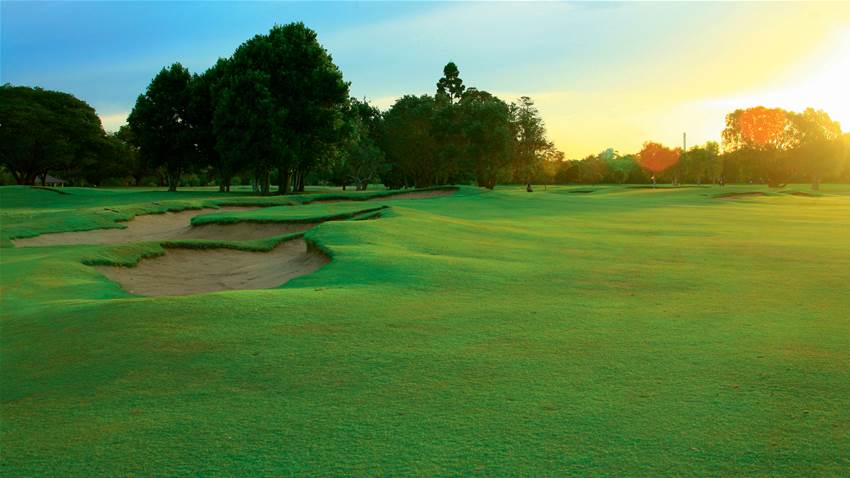The capital of Australia’s Sunshine State is blessed with warm subtropical weather all year round, making it an ideal destination for golfers seeking a shirt and shorts round at any time. Here, we showcase the Top-12 Courses you will find within a 45-minute drive of Brisbane’s city centre.
1 ROYAL QUEENSLAND GOLF CLUB
Royal Queensland will celebrate its centenary next year and many would argue the layout is currently the best it has ever been during the past 100 years.
Six years after the first shots were struck, legendary designer Dr Alistair MacKenzie visited the course and offered advice on some of the holes and the layout in general crafted by Carnegie Clark.
“The ground is excellently adapted for the construction of a golf course which might even compare favourably with some of the British Championship courses. The part of the ground for which the main course has been chosen is full of very fine golfing features. Although the ground at first sight appears flat, yet it is full of minor undulations of a somewhat similar character to famous seaside courses like St Andrews,” MacKenzie said of the course beside the Brisbane River.
However, the course was forced into change several times over the years with the construction of the two Gateway Bridges across the eastern end of the property.
The last major redesign – by Mike Clayton – was completed in 2007, two years after the State Government decided to build the second bridge, which claimed seven holes from the course.
The key to the redesign was to incorporate width into the fairways, have less rough and more short grass, which ultimately provides players – of all standards – a greater strategic golfing experience by offering more shot options into the vast greenscapes.
Green fee: $230. Visitors must provide written proof of a golf club membership and current official handicap.

2 BROOKWATER GOLF CLUB
When Brookwater opened to much fanfare in 2002 many were quick to draw comparisons with the home of the US Masters, Augusta National.
The varied terrain, creative bunkering and undulating putting surfaces bare a slight resemblance to parts of Augusta. The fact that Greg Norman and his then design chief Bob Harrison were responsible for creating the layout added further weight to the theory that Augusta inspired this layout in Brisbane’s south western suburbs.
But the truth is this par-72 is an original and there is an overwhelming Australian feel about the course with tall Eucalypts, tall wild grasses and the occasional kangaroo bounding across a fairway. The Norman and Harrison design is one of Australia’s most spectacular inland courses and is entrenched in the top half of the nation’s Top-100 Courses ranking.
Brookwater impresses from the opening tee shot. From the championship black markers, the 1st hole is a 380-metre par-4 where your drive must cross a deep valley to find the fairway rising up the other side. A drive of about 220 metres will have you standing on the crest of the hill, with the fairway veering and cambering left past spectacular fairway bunkering and descending towards the green, nestled between two bunkers and tall timbers.
The layout has dramatically improved in recent times after an extensive renovation that saw changes to its greens, upgrades to bunkers and the cutting back of some penal areas of rough to make the course more playable for the masses. As a result, the course has been restored to the playability intended by the original design, which makes it a must play layout when heading to Brisbane.
Green fee: $100 (18 holes, Monday to Thursday); $120 (Friday to Sunday).

The Brisbane Golf Club. PHOTO: Brendan James.
3 THE BRISBANE GOLF CLUB
Brisbane’s oldest club dates back to 1896 with the first complete 18-hole course, designed by Carnegie Clark, coming into play in 1904.
Two decades later, Dr Alister MacKenzie was invited to advise on what changes he might make to the course. He prepared a report which polarised the committee at the time and only some of his recommendations, mainly the addition of bunkers, were put into play.
Acclaimed designer Ross Watson was commissioned to come up with a masterplan for the layout in 2007 and several holes were upgraded as part of the multi-year plan. The biggest improvement to the layout came a few years ago with the conversion of all Brisbane’s greens to Champion Ultra Dwarf grass. After considerable testing by the club, the grass replaced its Bermuda 328 putting surfaces and now the greens are some of the best to be found in the Sunshine State.
Green fee: $150 (visitors from interstate, who can apply for a tee time through the general manager); $60 (member’s guest, plus fee if playing in a competition).
4 INDOOROOPILLY GOLF CLUB (West course)
Indooroopilly was the hardest hit golf club in the devastating Brisbane floods of 2011.
But, from that adversity, the club and its 36-hole complex emerged and has since improved significantly to have one of its six 18-hole combinations – the West Course – achieve an Australian Top-100 Course ranking in 2014, ‘16 and ’18.
Having been established at nearby St Lucia in 1926, the club added a course at Long Pocket in 1964 and within two decades it had developed 36 holes on the peninsula with Ross Watson redesigning the older holes, which were renamed the West Course and incorporate the Gold and Red nines.
In recent times, all the greens surrounds were converted to zoysia grass, which thrives in warmer climates, and now forms a barrier between the couch fairways and Bermuda greens.
Sand plays a dominant role on the West course outward half, or Gold nine, with expansive bunkering complexes on the par-5 3rd, par-4 6th and par-5 7th holes being the most visually intimidating across the entire Indooroopilly landscape.
Green fee: $75 (Monday to Thursday); $95 (Friday and Sunday).

Related Articles

Review: Omaha Beach Golf Club

Drinks With... Ricky Ponting













